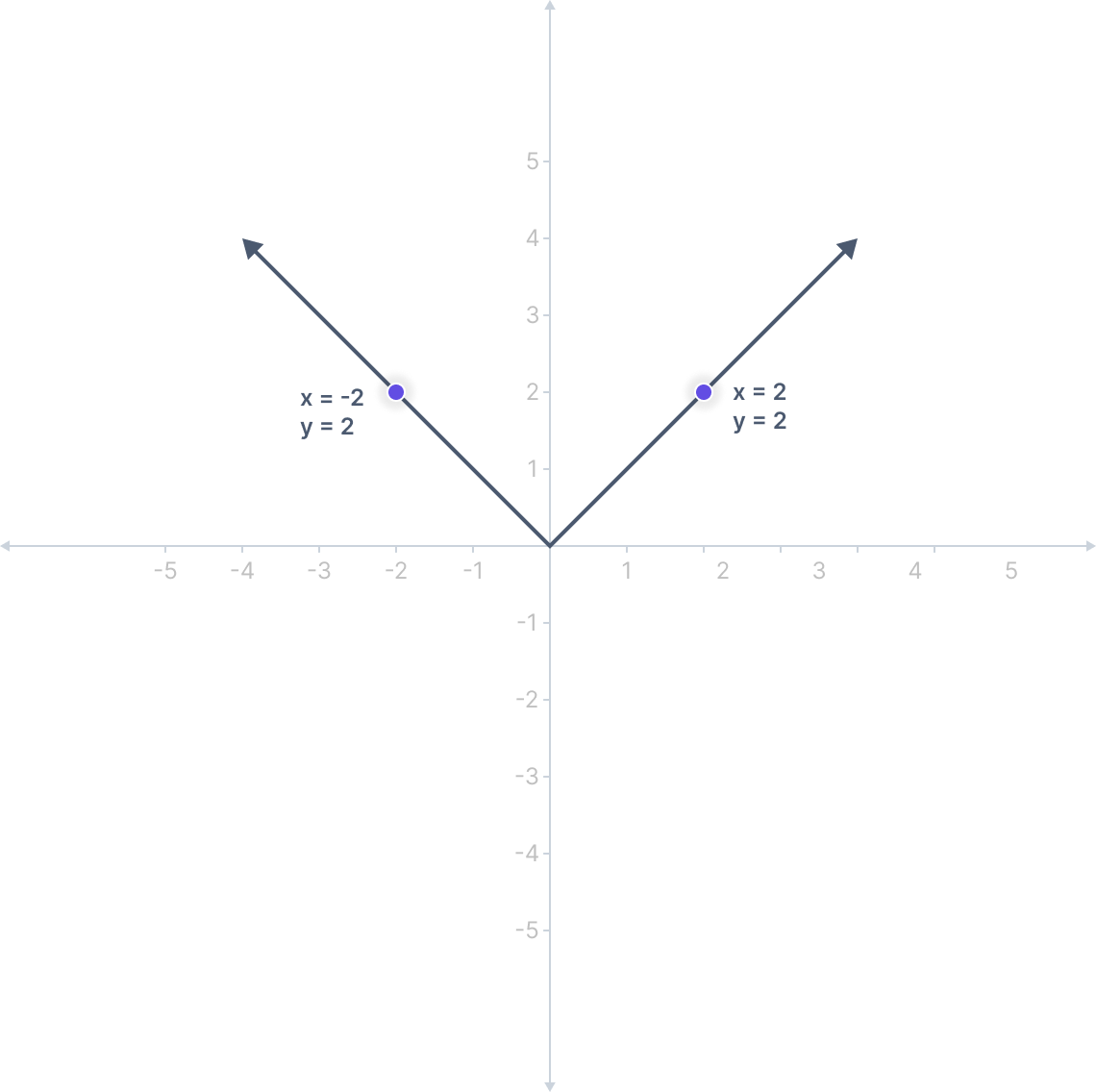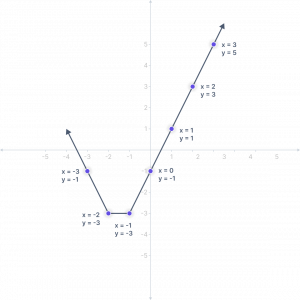Absolute Value Calculator is a free online tool that displays the absolute value for the given equation. The Mathematics Master online absolute value equations calculator application displays the absolute value of the variable in a matter of seconds speeding up the calculation.
The calculator solves the equation by displaying the graph, the solution’s integer values, and their number line representation. Here you can see the graph of equation \( y = |x| \):

Here you can see, whether x = 2 or x = -2, but absolute value of x is 2 in both cases.
What are Absolute Value Equations?
Absolute value equations are those that contain variables inside the absolute operator (modulus). In mathematics, an equation with an absolute value expression is known as an absolute value equation.
For instance,\( |x+1|=2\). Here, the absolute expression is \(|x+1|\). The absolute value shows how far away from zero the given integer is. Negative numbers are not permitted in this case. It is the magnitude or size of the number.
For eg., \(|-2| = 2\)
Since \(-2\) is 2 less than the value 0, it. As a result, \(-2\) has an absolute value of 2. These equations are applied to various real-world issues, including estimating distance, figuring out range, variance, etc.
How to graph absolute value function?
Example 1: Consider the equation: \( y = |2x + 3| – 4 \)
To graph this equation, first, we need to find y by assuming values for x. Here we will consider x = -3, -2, -1, 0, 1, 2, 3.
For x = -3, \( y = |2(-3) + 3| – 4 = |-6 + 3| – 4 = |-3| – 4 = 3 – 4 = -1 \)
For x = -2, \( y = |2(-2) + 3| – 4 = |-4 + 3| – 4 = |-1| – 4 = 1 – 4 = -3 \)
For x = -1, \( y = |2(-1) + 3| – 4 = |-2 + 3| – 4 = |-1| – 4 = 1 – 4 = -3 \)
For x = 0, \( y = |2(0) + 3| – 4 = |0 + 3| – 4 = |3| – 4 = 3 – 4 = -1 \)
For x = 1, \( y = |2(1) + 3| – 4 = |2 + 3| – 4 = |5| – 4 = 5 – 4 = 1 \)
For x = 2, \( y = |2(2) + 3| – 4 = |4 + 3| – 4 = |7| – 4 = 7 – 4 = 3 \)
For x = 3, \( y = |2(3) + 3| – 4 = |6 + 3| – 4 = |9| – 4 = 9 – 4 = 5 \)
Now we found these sets of (x, y): (-3, -1), (-2, -3), (-1, -3), (0, -1), (1, 1), (2, 3) and (3, 5). We can use these values to draw a graph. So, the graph for \( y = |2x + 3| – 4 \) will be:

Example 2: Consider the equation: \( y = |x| + 2 \)
For x = -3, \( y = |-3| + 2 = 3 + 2 = 5 \)
For x = -2, \( y = |-2| + 2 = 2 + 2 = 4 \)
For x = -1, \( y = |-1| + 2 = 1 + 2 = 3 \)
For x = 0, \( y = |0| + 2 = 0 + 2 = 2 \)
For x = 1, \( y = |1| + 2 = 1 + 2 = 3 \)
For x = 2, \( y = |2| + 2 = 2 + 2 = 4 \)
For x = 3, \( y = |3| + 2 = 3 + 2 = 5 \)
Now we found these sets of (x, y): (-3, 5), (-2, 4), (-1, 3), (0, 2), (1, 3), (2, 4) and (3, 5). We can use these values to draw a graph. So, the graph for \( y = |x| + 2 \) will be:

How to Use the Absolute Value Calculator?
Follow these steps to use the Absolute Value Calculator:
- Type the equation into the text box.
- To obtain the outcome, press the “Solve” button now.
- The equations for absolute values will then be shown.
The calculator is dependable and effective because it gives you the most precise and correct answers. Moreover, this calculator is free, in contrast to other online tools. It functions in your browser and doesn’t need to be downloaded or installed. Its user interface is simple, making it easy for anyone to use and navigate.
FAQs
How do you solve absolute value equations?
- Isolate the absolute value on one side of the equation to solve an equation with an absolute value.
- Then, resolve both equations by setting their respective contents to the positive and negative values of the integer on the other side of the equation.
- Work out \(| x | + 2 = 5\). Isolate the absolute value.
How to solve absolute value inequalities?
Similar processes apply to both calculating an absolute value inequality and an absolute value equation:
- Isolate the absolute value on one side of the inequality.
- Solve the inequality’s “positive version.”
- To solve the inequality’s negative “variant,” multiply the value on the other side by 1, then reverse the inequality sign.
Alternatively, you can use an absolute value inequalities calculator.
Can't find your query?
Fill out the form below with your query and we will get back to you in 24 hours.
Most commonly used free online Calculators
The most Popular Blogs among people

Cartesian Coordinates System – Dimensions, Formula...
Cartesian coordinates, sometimes called rectangular coordinates, are t...

Math Playground: A Hands-On Approach to Learning M...
Step into the math playground, where the wonders of numbers come to li...

How to Graph a Parabola – Formula, Properties, and...
When you discharge an arrow or throw a stone, it arcs into the air and...